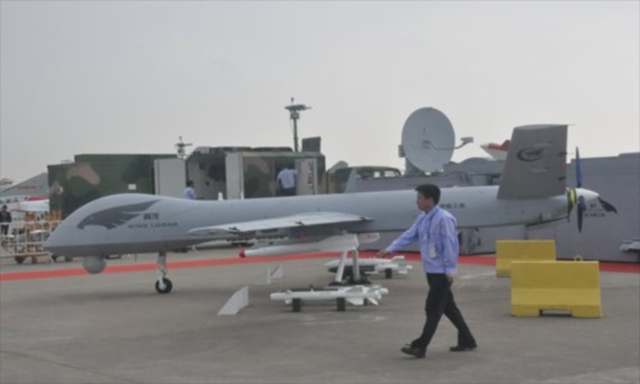 Wing Loong
Wing Loong
Several types of Unmanned Aircraft Systems were on public display at Airshow China 2012 last week with some foreign sales being reported.
Among the aircraft displayed Wednesday at the show in Zhuhai, Guangzhou Province, is the Chengdu Aircraft Design & Research Institute’s (CADI’s) Wing Loong I and the China Aerospace Science and Technology Corporation’s CH-4.
Both aircraft are capable of carrying considerable weapon payloads.
They appear similar to the US-made MQ-9 Reaper, which has been used by the US military and intelligence agencies to conduct surveillance and hunter-killer missions in regional wars and anti-terrorist and insurgency operations.
The two Chinese aircraft were designed to be controlled by a ground station via satellite relay.
The export versions are controlled only by ground stations, limiting their range and to conform to international arms sale regulations.
Li Yidong, Vice-General Designer for the CADI, told the Global Times that the Wing Loong I is similar to the US MQ-9 Reaper in terms of mission capability, but has a lower operating cost.
As suggested by the number of red stars and missile patterns painted on the Wing Loong I, the drone on display appears to have carried out 20 missions and fired 15 missiles, suggested Li.
Compared with the Wing Loong I, the CH-4 is a multi-role UAS that can fly a wide range of civilian missions from national resource surveillance to communication signal relay, Huang Wei, the drone’s programme supervisor, told the Global Times.
With a wingspan of about 18 meters, the CH-4 has four under-wing pylons capable of carrying missiles and satellite guided precision bombs. Along with optical sensors, it is also fitted with a ground search radar.
“We developed the CH-4 on foreign sales. According to our client’s demands, most of the airframe is made of composite materials. It is light and needs less maintenance in harsh environments,” said Huang, adding that with a range of more than 3,500 kilometers the drone would be ideal to conduct surveillance missions over the waters of the Diaoyu and Huangyan Islands.
“As the Americans say, the UAS is fit for missions that are dirty, dangerous and dull,” Huang said.
When asked to comment on predictions that the next-generation fighter aircraft will also be unmanned, Li said that the UAS’ future development still face uncertainties.
“No one can guarantee the absolute safety of the data link connecting the drone and the control station, especially when the two sides at war have similar capabilities in electronic warfare and countermeasures,” Li said.
“Another important factor that is impossible to predict is how artificial intelligence will evolve in the future,” Li added at the airshow.
Source: Global Times
